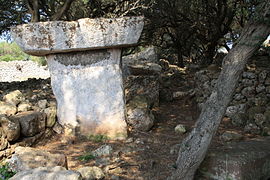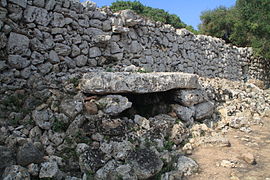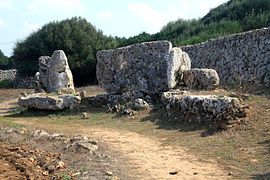Torrellafuda
| Torrellafuda Poblat Talaiotic de Torrellafuda | ||
|---|---|---|
|
Site of the Taula |
||
|
Location in Menorca |
||
| Coordinates | 39 ° 59 '55.7 " N , 3 ° 55' 20.9" E | |
| place | Ciutadella , Balearic Islands , Spain | |
| Emergence | 1000 to 700 BC Chr. | |
| Dimensions | 90 m | |
| height | 120 m | |
Torrellafuda (also Torre Llafuda , full name Poblat Talaiòtic de Torrellafuda , "Talayotic settlement of Torrellafuda") is an archaeological site on the Spanish Balearic island of Menorca . The settlement, which is assigned to the Iron Age talayot culture , is located in the municipality of Ciutadella in the west of the island.
location
Torrellafuda is seven kilometers east of Ciutadella and 500 m south of the island road ME-1, from which the site can be reached via the Son Camps. A parking lot is available for visitors. The site of the former talayotic settlement is freely accessible. Display boards of the Xarxa Menorca Monumental give the visitor information about the site.
history
The beginnings of the settlement are in the early Iron Age between 1000 and 700 BC. In the 1960s it was partially excavated by María Petrus. The results of the excavations allowed the conclusion that Torrellafuda was last inhabited in the 1st century AD. In 2002, however, Fèlix Retamero and Miquel Barceló i Perelló (1939–2013) from the Autonomous University of Barcelona also found artifacts from the Islamic period from the 10th to 13th centuries.
Torrellafuda has been protected as an archaeological monument ( Monument arqueològic ) since 1966 . His current registration number at the Spanish Ministry of Culture is RI-55-0000822.
It is one of the 32 archaeological sites that Spain officially proposed on January 14, 2016 as " Talayotic Culture of Menorca " for inclusion on the UNESCO World Heritage List . The World Heritage Committee postponed the application at its 41st meeting in July 2017 and requested improvements.
Buildings
The great talayot (2011). The surveying pillar has since been removed.
Talayots
A large talayot , a megalithic tower in the shape of a truncated cone , stands at the highest point of the settlement 120 m above sea level. It is not solidly built, but was hollow when the complex was settled. It is relatively well preserved, only the upper area around the collapsed roof shows severe damage. The residential buildings that leaned against its walls have been completely destroyed.
The tower must have been of central importance to the west of Menorca. Seven other talayots in the area and the sea can be seen from its platform. The design suggests that it also as addition to his functions as a watchtower and for communication with neighboring settlements granary could have been used. It is dated between 850 and 550 BC. Dated.
The foundations of a second talayot are further east, near the access path from the parking lot.
The site of the taula
As in other Menorcan megalithic settlements, a taula sanctuary has also been found in Torrellafuda. The building had the typical horseshoe-shaped floor plan and a slightly concave facade. The excavations in the 1960s concentrated on this area, which is now located in a holm oak forest . The taula itself, the second largest to this day after that of Trepucó , fell over and its stones were broken. The load-bearing monolith was 3.86 m high. It was 2.00 to 2.10 m wide and 0.35 m thick. A capstone in the shape of a truncated pyramid was placed over it, which was 2.68 to 2.76 m long, 1.36 to 1.46 m wide and 0.62 m thick. The resulting table-like structure was shaped like the letter "T". The taula was supported from behind by another pillar. The best-preserved part of the building is a pillar with a capital that resembles a taula in appearance.
The site of the taula is younger than the talayot and dates back to between the 5th century BC. Chr. And the 1st century. AD. The excavations were local, not using the potter's wheel made pottery discovered. Other finds were pottery from Megara and Italy.
The walls
In Torrellafuda part of the outer wall protecting the settlement from the period from 1000 to 800 BC is visible. Chr. Preserved. For the construction, stones of small and medium size were piled up to a considerable height. Three megalithic entrances, some of which have been reinforced, can still be seen. However, large parts of the wall have probably only recently been erected on older remains.
Hypogeum and round houses
On the way from the parking lot to the talayot there are the remains of two late alayotic houses made of large stone blocks that rest on plinths . The facades of these houses have not been preserved, only their backs. On the left there is an underground burial place ( hypogeum ) from the late Alayotic period. The spherical cave has been artificially driven into the rock. Today it serves as a goat shed.
Web links
Individual evidence
- ↑ a b c Tomàs Vibot: Archaeological tour through Menorca , El Gall Editor, Pollença 2006, ISBN 978-84-96608-30-6 , p. 51f.
- ↑ a b The Talayotic Menorca (PDF; 33 MB), ohDigital, 2013, p. 64.
- ↑ a b Torrellafuda talayotic settlement on the Menorca Talayótica website, accessed on March 20, 2015.
- ↑ Talayotic Culture of Minorca , on the Spanish tentative list at UNESCO (English), accessed on October 28, 2017.
- ↑ World Heritage Committee (Ed.): List of nominations received by February 1, 2016 and for examination by the World Heritage Committee at its 41st session (2017) . (English, unesco.org [PDF; 427 kB ]).
- ↑ World Heritage Committee (Ed.): Decisions adopted during the 41st session of the World Heritage Committee (Krakow, 2017) . ( unesco.org ).
- ↑ a b Corinna Kortemeier: Reconstruction of the prehistoric settlement and landscape development on Menorca (Balearic Islands / Spain) (PDF; 11.4 MB), dissertation, Christian-Albrechts-Universität zu Kiel , Kiel 2014.
- ↑ a b c Antoni Nicolau Martí, Elena Sintes Olives, Ricard Pla Boada, Albert Àlvarez Marsal: Talayotic Minorca . The prehistory of the island. Triangle Books, Sant Lluís 2015, ISBN 978-84-8478-640-5 , pp. 252-257 (English).
- ↑ a b Ferran Lagarda i Mata: The archeology of Minorca on the website www.arqueoguia.com (Note: Select "Prehistoric Archeology", "Taulas", "Torrellafuda").
- ↑ a b Information board of the Xarxa Menorca Monumental at the site.
- ↑ Ferran Lagarda i Mata: The archeology of Minorca on the website www.arqueoguia.com (note: select “Prehistoric Archeology”, “Walls”, “Torrellafuda”).







